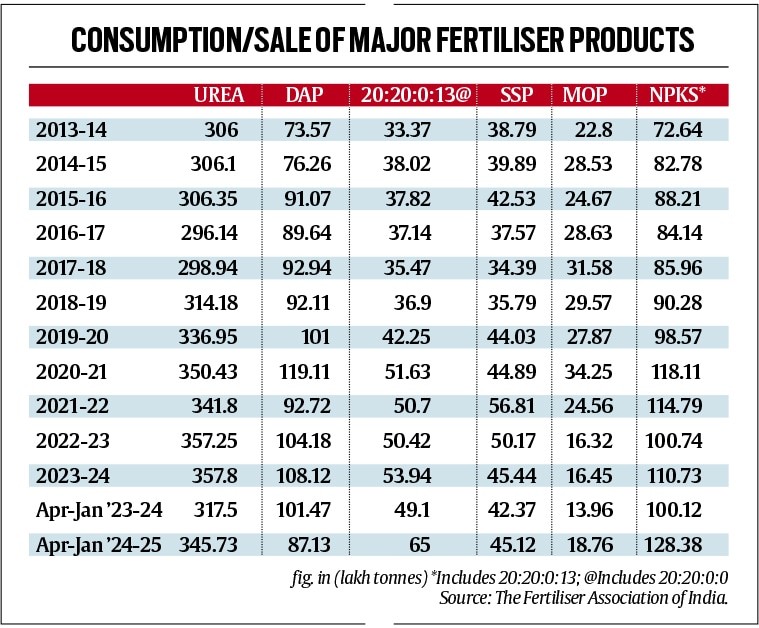Reducing India's Dependence on Imported Fertilisers

- 27 Feb 2025
Context
The Indian government is strategizing to cap or reduce the consumption of high-analysis fertilizers—Urea, Di-Ammonium Phosphate (DAP), and Muriate of Potash (MOP)—due to their heavy import dependence, rising economic burden, and adverse environmental impacts. This shift is crucial for ensuring nutrient balance, reducing foreign exchange outflows, and promoting sustainable agriculture.
India’s Dependence on Imported Fertilisers
- MOP: India is fully dependent on imports from countries like Canada, Russia, Jordan, Israel, Turkmenistan, and Belarus, as it has no mineable potash reserves.
- Urea: While over 85% of urea demand is met domestically, production relies on imported liquefied natural gas (LNG) from Qatar, the US, UAE, and Angola.
- DAP: Imported both as finished fertiliser and raw materials (rock phosphate, sulphur, phosphoric acid, ammonia) mainly from Saudi Arabia, Morocco, Jordan, China, and others.
The Need to Limit High-Analysis Fertiliser Usage
Economic Concerns
- The rupee's depreciation increases fertiliser import costs.
- India spent ?1.75 lakh crore on fertiliser subsidies in 2023-24.
- Subsidised urea is sold at rates far below cost, draining government resources and encouraging overuse.
- DAP's landed price stands at ?55,150 per tonne, with production costs exceeding ?65,000 per tonne, while the government-fixed retail price remains ?27,000 per tonne, necessitating large subsidies.
Environmental Concerns
- Excessive application of urea and DAP depletes organic carbon in soils, reduces microbial diversity, and causes groundwater contamination through nitrate leaching.
- Soil health degradation ultimately reduces crop productivity and ecological resilience.
Governance Challenges
- High subsidies encourage black marketing and non-agricultural diversion.
- Lack of strict nutrient management regulations leads to soil nutrient imbalances.
The Shift Towards Balanced Fertilisation
High-analysis fertilisers like urea (46% nitrogen), DAP (46% phosphorus + 18% nitrogen), and MOP (60% potash) often lead to over-application and inefficiency. Crops instead require a balanced supply of:
- Macronutrients (N, P, K),
- Secondary nutrients (sulphur, calcium, magnesium),
- Micronutrients (zinc, iron, copper, boron, manganese, molybdenum).
Balanced fertilisation ensures efficient nutrient uptake, enhances yields, preserves soil health, and optimises resource use.
Emerging Alternatives
Ammonium Phosphate Sulphate (APS – 20:20:0:13)
- Contains 20% N, 20% P, and 13% S, but no K.
- Sulphur-rich, making it ideal for oilseeds, pulses, maize, cotton, onion, and chilli.
- APS manufacturing is more economical, requiring less costly phosphoric acid compared to DAP.
- Sales surged 32.4%, from 4.9 million tonnes (2022-23) to 6.5 million tonnes (2023-24), making APS the third-most consumed fertiliser after urea and DAP.
- Leading APS producers include Coromandel International, Paradeep Phosphates, and Mangalore Chemicals & Fertilizers.
Single Super Phosphate (SSP – 16% P, 11% S)
- A low-cost, sulphur-rich fertiliser ideal for oilseeds and vegetable cultivation.
Nano Urea and Nano DAP
- Developed by Indian Farmers Fertiliser Cooperative (IFFCO).
- Enhance nutrient use efficiency by 15–20%, require lower application rates, and reduce overall fertiliser consumption.
NPKS Complex Fertilisers
- Formulations like 10:26:26:0, 12:32:16:0, 15:15:15:0, and 14:35:14:0 provide balanced nutrients.
- Help integrate potash application into complexes, reducing direct MOP use.
- NPKS fertiliser sales are projected to reach 14 million tonnes in 2024-25, up from 7.3 million tonnes in 2013-14.
Biofertilisers and Organic Manure
- Promote sustainable farming by improving soil health and reducing chemical fertiliser dependence.
- Supported by government initiatives like the PM-PRANAM scheme.
Effectiveness of Substitutes
- Reduces Import Costs: APS and Nano Urea reduce foreign exchange outflows.
- Enhances Soil Health: Balanced fertilisers prevent soil degradation and restore fertility.
- Improves Crop Yields: Trials demonstrate better nutrient absorption and yield improvements.
- Promotes Sustainability: Encourages ecological farming practices.
Policy Support and The Way Forward
Government Initiatives
- PM-PRANAM Scheme: Promotes alternative fertilisers.
- Nutrient-Based Subsidy (NBS): Encourages balanced fertiliser use.
- Soil Health Card Campaign: Educates farmers about soil-specific nutrient needs.
Strategic Recommendations
- Subsidy Reforms: Focus subsidies on APS, Nano Urea, and complex fertilisers rather than high-analysis fertilisers.
- Technology Adoption: Use AI-based tools like Microsoft FarmVibes AI for precision fertiliser application.
- Domestic R&D Investment: Strengthen indigenous production of fertilisers and biofertilisers.
- Policy Alignment: Integrate fertiliser policy with climate change and agricultural sustainability strategies.
Conclusion
India’s high dependence on imported urea, DAP, and MOP is economically unsustainable and environmentally detrimental. Transitioning towards balanced fertilisers like APS, Nano Urea, and organic alternatives is critical for ensuring long-term agricultural sustainability, reducing subsidy burdens, conserving foreign exchange, and preserving soil health. This shift requires concerted efforts through government policy, farmer education, and technological innovation.
